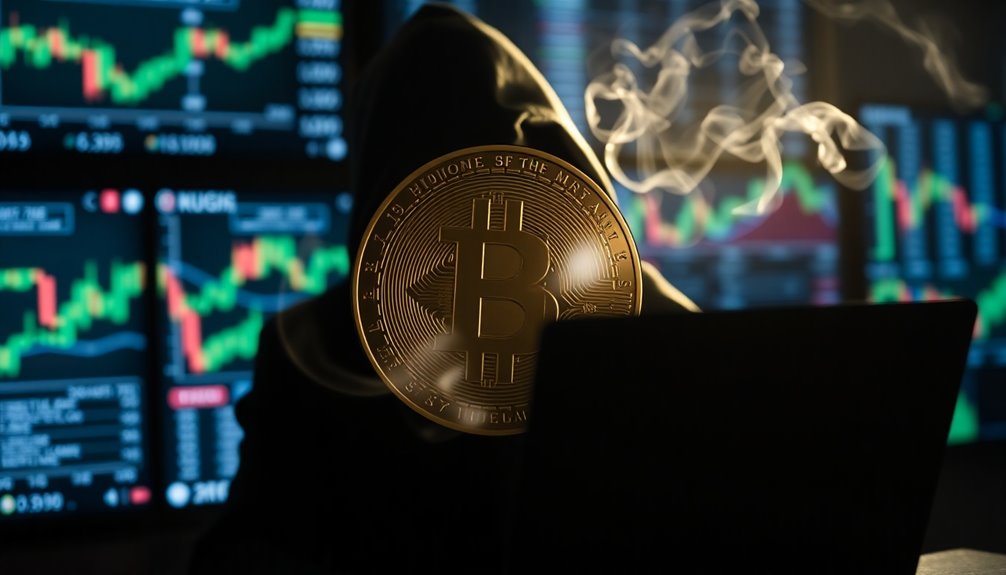Huione's stablecoin is set to launch in September 2024, but it's already generating buzz due to its controversial ties to the dark web. With over 900,000 users, primarily drawn to online gambling, its decentralized nature raises serious regulatory concerns. Lacking typical freeze or transfer limitations, it might attract illicit activities, prompting regulators to seek clarity. This environment is complicated by cryptocurrency volatility, which hinders broader adoption. As Huione navigates these challenges, it might reshape the digital currency landscape, leaving you curious about how this saga unfolds.
Key Takeaways
- Huione's stablecoin launch in September 2024 raises compliance concerns due to its decentralized nature and appeal to illicit actors.
- The absence of freezing or transfer limitations makes the stablecoin attractive for illegal activities, including potential links to the dark web.
- Regulatory scrutiny has intensified following enforcement actions against established stablecoins like Tether, increasing the urgency for clarity.
- The cryptocurrency's inherent volatility complicates its adoption, impacting investor confidence and raising concerns over its stability.
- Huione's user base, primarily from online gambling, further fuels concerns about potential misuse and connections to dark web transactions.
Launch of Huione's Stablecoin

Huione has officially launched its stablecoin, generating buzz across the crypto community.
Set for a September 2024 debut, this stablecoin operates on Ethereum, BSC, Tron, and Huione's Xone chain. It's marketed as a way to bypass restrictions common with traditional stablecoins like USDT and USDC. Tether recently froze 29.62 million USDT linked to criminal activities associated with the Cambodian Huione Group, highlighting concerns surrounding the integrity of new stablecoin entrants. This situation underscores the importance of regulatory compliance within the cryptocurrency market.
With no regulatory oversight, it appeals to those looking for decentralized options. The launch included an Initial Coin Offering (ICO) aimed at increasing accessibility.
As the market swells, monthly crypto inflows have surged by 51%, reaching over $24 billion in transactions.
With a user base exceeding 900,000, Huione's stablecoin primarily supports online gambling, raising concerns about its potential use in illicit activities. The lack of oversight may also lead to increased volatility and risks for investors.
Regulatory Scrutiny Intensifies

As the launch of Huione's stablecoin gains traction, regulatory scrutiny is quickly ramping up. The decentralized nature of USDH raises significant compliance concerns, as it operates with minimal oversight, making it attractive to illicit actors. Unlike USDT and USDC, USDH lacks freezing or transfer limitations, allowing bad actors to exploit its features. Current regulatory frameworks focus more on enforcement than proactive rulemaking, creating ambiguity in the industry. Federal regulators struggle to establish authority over various sectors, raising policy questions about tailored regulations. Meanwhile, enforcement actions, like Tether freezing USDT linked to criminal activities, highlight the urgent need for clearer guidelines. The launch of USDH may further facilitate illicit transactions within the cryptocurrency market, increasing the urgency for regulatory intervention. As Huione continues its operations, the pressure for regulatory clarity only intensifies.
Cryptocurrency Volatility Impacts Adoption

While the allure of cryptocurrencies continues to grow, the inherent volatility often acts as a significant roadblock to widespread adoption.
You might find that rapid price swings can shake investor confidence, making it hard for newcomers to take the plunge. High market volatility often scares away potential investors, who fear significant losses.
Even those seeking short-term gains face challenges in such an unpredictable environment.
Here are some factors impacting cryptocurrency adoption:
- Price swings affect investor confidence.
- High volatility deters new investors.
- Short-term gains are hard to achieve.
- Many believe in long-term potential despite volatility.
- Risk management strategies can help mitigate risks.
Understanding these aspects is essential for maneuvering the ever-changing landscape of digital currencies. Moreover, incorporating AI-driven solutions can enhance risk assessment and decision-making, potentially improving investor confidence in the crypto market.
Corporate Investment Trends

With the rise of digital currencies, companies are increasingly integrating cryptocurrencies into their investment strategies, recognizing both opportunities and challenges.
For instance, MicroStrategy's Treasury Management Strategy showcases effective crypto use, investing $250 million in Bitcoin to hedge against inflation, resulting in increased stock returns.
Similarly, Marathon Digital Holdings focuses on digital asset mining, enhancing equity returns and financial stability.
Tesla, on the other hand, embraces crypto as a payment method, broadening its transactional scope.
While these trends present new investment opportunities and operational advantages, companies must also tackle regulatory, accounting, and tax challenges.
Successful adoption demands strong leadership and collaboration across multiple departments to navigate the complexities of the digital asset ecosystem effectively. Moreover, firms can benefit from understanding the impact of cryptocurrency holdings on their overall risk profiles and stock performance.
Government Lobbying Efforts

Companies are increasingly aware that steering through the digital currency landscape requires not just smart investments but also strategic government lobbying efforts.
By engaging in lobbying, you can influence regulatory frameworks that directly affect your operations.
Here are some key aspects of effective lobbying:
- Regulatory Framework: Push for favorable laws and regulations.
- Financial Support: Contribute to political campaigns through PACs.
- Public Relations: Shape public perception via media outreach.
- International Influence: Build partnerships to expand your lobbying reach.
- Legal Compliance: Guarantee compliance with existing regulations to avoid setbacks.
These strategies help create a more favorable business environment, allowing your company to thrive amidst regulatory challenges and public scrutiny.
Market Adoption Predictions

As Huione's stablecoin enters the market, mixed public reactions highlight the challenges it faces in gaining widespread adoption.
While some investors are intrigued, others hesitate due to concerns about dark web ties. Regulatory scrutiny adds another layer of complexity, potentially hindering growth. Community discussions on social media reflect a blend of skepticism and hope, leading to increased market volatility.
However, the stablecoin's robust blockchain integration and smart contract technology promise reliability and security. If it can guarantee compliance and innovate continuously, it may capture a broader user base.
With the potential for economic stability and improved financial inclusion, Huione's stablecoin could thrive if it navigates these hurdles effectively.
Frequently Asked Questions
What Features Differentiate Huione's Stablecoin From Others on the Market?
Huione's stablecoin stands out with its advanced algorithmic stability, ensuring supply adjusts dynamically to market conditions.
You'll appreciate the overcollateralization feature, which mitigates risks effectively. Its decentralized governance empowers you to influence decisions, while cross-chain compatibility enhances transaction flexibility.
The user-friendly interface makes managing your assets easy, and low fees keep costs down.
Plus, with 24/7 customer support and educational resources, you'll have all the tools you need for a smooth experience.
How Can Users Purchase and Store Huione's Stablecoin Securely?
To purchase and store Huione's stablecoin securely, start by using USDT for transactions through payment apps or bank transfers.
Opt for hardware wallets like Ledger or Trezor for safe storage, or consider reputable software wallets with added security.
Implement cold storage solutions for extra protection and use multi-signature wallets for enhanced security.
Regularly monitor transactions with blockchain analysis tools and stay updated on security practices to guarantee your assets remain safe.
What Are Potential Risks Associated With Using Huione's Stablecoin?
Imagine standing at the edge of a turbulent sea, unsure if the waves will pull you under.
That's how using Huione's stablecoin can feel. You face risks like sudden redemption spikes leading to asset fire sales, cyber-attacks from unregulated issuers, and the looming shadow of money laundering.
Without solid regulation and transparency, you might find yourself traversing treacherous waters, where your funds could vanish without a trace.
Is Huione's Stablecoin Backed by Any Physical Assets or Reserves?
Yes, Huione's stablecoin, USDtb, is backed by reserves, specifically 90% allocated to BlackRock's USD Institutional Digital Liquidity Fund (BUIDL).
This fund invests in short-term U.S. Treasury bills, cash, and repurchase agreements, ensuring a high degree of stability.
While it primarily focuses on government-issued assets, it doesn't explicitly mention physical assets.
What Measures Does Huione Take to Ensure Compliance With Regulations?
You'd think Huione employs a thousand watchdogs to guarantee compliance with regulations!
In reality, they focus on transaction monitoring and screening to detect any suspicious activity. By integrating blockchain analytics, they track transactions related to their stablecoin and other offerings.
Additionally, they've expanded their operations, including a crypto exchange and wallet, while trying to maintain necessary oversight.
Despite these efforts, ongoing scrutiny remains a challenge for them.
Conclusion
As Huione's stablecoin launches amid controversy, it's a stark reminder of the duality in crypto—innovation versus scrutiny. While some embrace its potential for financial stability, others fear the dark web ties could taint its reputation. You're left to ponder: will this new asset thrive in the volatile market, or will regulatory pressures stifle its growth? The future could see a flourishing ecosystem or a cautionary tale, and your choice will shape its destiny.









